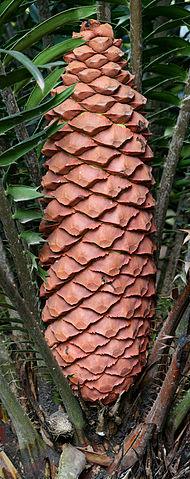A brief overview:
Plants have female reproductive organs (carpels) and male reproductive organs (stamens), but several different ways of determining sex. There are two main groups of seed-producing plants.
Gymnosperms are plants without covered seeds, and include those that produce cones. Gymnosperms and are split with about 75% exhibiting monoecy (having male and female sex organs on the same plant), and 25% exhibiting dioecy (having separate male plants and female plants).
 |
| Photo by Muhammad Mahdi Karim, via Wikimedia Commons |
 |
| Photo by Derek Ramsey, at Chanticleer Garden, via Wikimedia Commons |
Persimmon
A Y-chromosome–encoded small RNA acts as a sex determinant in persimmons
Takashi Akagi1,2, Isabelle M. Henry1, Ryutaro Tao2,*, Luca Comai1,*
 |
| Photo by Σ64, via Wikimedia Commons |
Identification of molecular markers for selection of supermale (YY) asparagus plants.
Gebler P, Wolko Ł, Knaflewski M.
 |
| Photo by Rasbak, via Wikimedia Commons |
Sex-determining chromosomes and sexual dimorphism: insights from genetic mapping of sex expression in a natural hybrid Fragaria × ananassa subsp. cuneifolia.
Govindarajulu R, Liston A, Ashman TL.
 |
| Photo via Walter Siegmund, via Wikimedia Commons |
Accumulation of interspersed and sex-specific repeats in the non-recombining region of papaya sex chromosomes.
Na JK, Wang J, Ming R.
 |
| Photo by Sakurai Midori, via Wikimedia Commons |
A small XY chromosomal region explains sex determination in wild dioecious V. vinifera and the reversal to hermaphroditism in domesticated grapevines.
Picq S, Santoni S, Lacombe T, Latreille M, Weber A, Ardisson M, Ivorra S, Maghradze D, Arroyo-Garcia R, Chatelet P, This P, Terral JF, Bacilieri R.
 |
| Photo by Bangin, via Wikimedia Commons |
So, yes, plants have sex, and some even have sex chromosomes. Just something to keep in mind as you work towards fulfilling your daily servings of fruits and veggies.
No comments:
Post a Comment